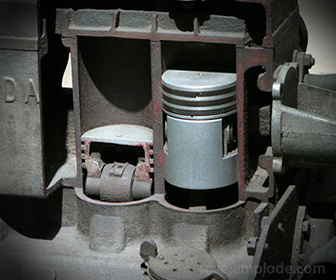Internal Energy In Thermodynamics
Physics / / July 04, 2021
The Internal energy is the thermodynamic quantity that is equal to the sum of all the energies of a system, such as kinetics and potential. It has been represented as E, and sometimes as U.
E = Ec + Ep +…
It is the one that defines the First Law of Thermodynamics. This law establishes the energy conservationIn other words, it is neither created nor destroyed. In other words, this law is formulated by saying that for a given quantity of a form of disappearing energy, another form of it will appear in an equal amount to the missing amount.
Being a unit of Energy, is measured in Joule (J) units, according to the International System of Units.
The First Law of Thermodynamics is explained with some amount of heat "q" added to the system. This quantity will give rise to an increase in the internal energy of the system, and will also do some external work "w" as a consequence of said heat absorption.
ΔE + w = q
ΔE = q - w
If we declare as ΔE the increase in Internal Energy of the system and “w” the work done by the system on the contour, then we will have the previous formula.
The equation constitutes the mathematical establishment of the First Law of Thermodynamics. As the internal energy depends only on the state of a system, then the change of it ΔE, involved in the passage of a state where the internal energy is E1 to another where is E2 must be given by:
ΔE = E2 - E1
ΔE thus depends only on the initial and final states of the system and in no way on the way in which such a change has been made.
These considerations do not apply to "w" and "q", because the magnitude of these depends on the way in which the work is done in the passage from the initial state to the final state.
The symbol "w" represents the total work done by a system. In a galvanic cell, for example, w can include the Electric Power provided, plus, if there is a change volume, any energy used to effect expansion or contraction against an opposing pressure "P".
The change in volume is best seen in the piston of an internal combustion engine, for example. The work done by the system against an opposing pressure "p", which is the external one, and with a change in Volume from V1 up to V2, is described with the formula:
w = pΔV

If the only work done by the system is of this nature, then the substitution of this equation in the First Law of Thermodynamics is:
ΔE = q - w -> ΔE = q - pΔV
The equations of the First Law of Thermodynamics are perfectly general and apply to the calculation of the Change of Internal Energy ΔE, Work w, Heat q. However, under special conditions these equations can take particular forms.
1.- When the Volume is Constant: if the volume does not vary, then ΔV = 0, and the work w will be 0. Therefore, it is only considered:
ΔE = q
2.- When the opposition pressure p is zero: A process of this type is called Free Expansion. Therefore, if p = 0, then w will be calculated as w = 0. Again:
ΔE = q
The quantities q, w and ΔE are experimentally measurable, but the magnitudes of E as such are not; This last fact is not an obstacle in Thermodynamics, since we are interested mainly in the changes of E (ΔE), and not in the absolute values.
Examples of internal energy
1.- Using the First Law of Thermodynamics, calculate the change in internal Energy of a system to which a heat of 1500 Joules has been added, and has managed to perform a work of 400 Joules.
ΔE = q - w
ΔE = 1500 J - 400 J
ΔE = 1100 J
There was an increase in internal energy
2.- Using the First Law of Thermodynamics, calculate the change in internal energy of a system to which a heat of 2300 Joules has been added, and has managed to perform a work of 1350 Joules.
ΔE = q - w
ΔE = 2300 J - 1350 J
ΔE = 950 J
There was an increase in internal energy
3.- Using the First Law of Thermodynamics, calculate the change in internal Energy of a system to which a heat of 6100 Joules has been added, and has managed to perform a work of 940 Joules.
ΔE = q - w
ΔE = 6100 J - 940 J
ΔE = 5160 J
There was an increase in internal energy
4.- Using the First Law of Thermodynamics, calculate the change in internal Energy of a system to which a heat of 150 Joules has been added, and has managed to do a work of 30 Joules.
ΔE = q - w
ΔE = 150 J - 30 J
ΔE = 120 J
There was an increase in internal energy
5.- Using the First Law of Thermodynamics, calculate the change in internal Energy of a system to which a heat of 3400 Joules has been added, and has managed to perform a work of 1960 Joules.
ΔE = q - w
ΔE = 3400 J - 1960 J
ΔE = 1440 J
There was an increase in internal energy
6.- Using the First Law of Thermodynamics, calculate the change in internal energy of a system to which a heat of 1500 Joules has been added, and has managed to perform a work of 2400 Joules.
ΔE = q - w
ΔE = 1500 J - 2400 J
ΔE = -900 J
There was a decrease in internal energy
7.- Using the First Law of Thermodynamics, calculate the change in internal Energy of a system to which a heat of 9600 Joules has been added, and has managed to perform a work of 14000 Joules.
ΔE = q - w
ΔE = 9600 J - 14000 J
ΔE = -4400 J
There was a decrease in internal energy
8.- Using the First Law of Thermodynamics, calculate the change in internal Energy of a system to which a heat of 2800 Joules has been added, and has managed to perform a work of 3600 Joules.
ΔE = q - w
ΔE = 2800 J - 3600 J
ΔE = -800 J
There was a decrease in internal energy
9.- Using the First Law of Thermodynamics, calculate the change in internal Energy of a system to which a heat of 1900 Joules has been added, and has managed to perform a work of 2100 Joules.
ΔE = q - w
ΔE = 1900 J - 2100 J
ΔE = -200 J
There was a decrease in internal energy
10.- Using the First Law of Thermodynamics, calculate the change in internal Energy of a system to which a heat of 200 Joules has been added, and has managed to perform a work of 400 Joules.
ΔE = q - w
ΔE = 200 J - 400 J
ΔE = -200 J
There was a decrease in internal energy


